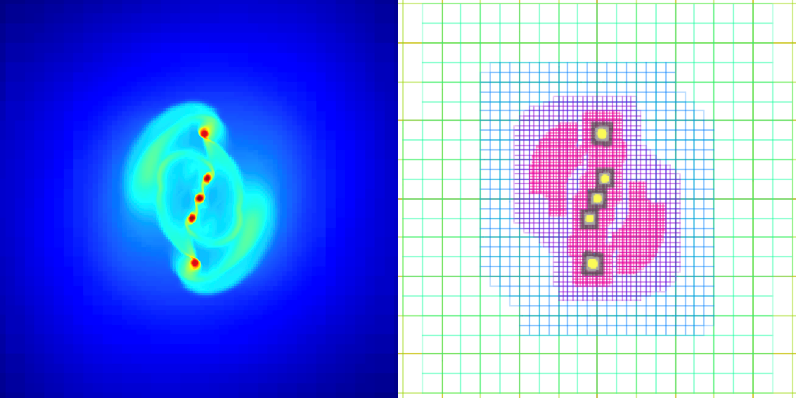RAMSES
Responsible Partners: CNRS/CRAL

RAMSES is an open source code written by Romain Teyssier (Princeton University) to model astrophysical systems, featuring self-gravitating, magnetised, compressible, radiative fluid flow. It has been widely used for cosmological simulations of the Universe, isolated as well as cosmological re-simulations of individual galaxies, simulations of molecular clouds, star formation, supernovae remnants, accretion disks around black holes and planets.
RAMSES is an Adaptive-Mesh-Refinement (AMR) code which is used to study astrophysical fluid dynamics and the formation of structures in the Universe. It is based on an oct-tree structure, where parent cells are refined into children cells on a cell-by-cell basis following some user-defined criteria. RAMSES can deal with 1D, 2D and 3D Cartesian grids. RAMSES uses an explicit second-order predictor-corrector finite-volume Godunov scheme to integrate the conservative system of equations. The hydrodynamic solver consists of computing flux at cell interfaces, including coarse-to-fine and fine-to-coarse interfaces.
RAMSES can also handle the evolution of particles, such as stars, Dark Matter (DM) and sink particles, whose evolution is integrated using a Cloud-in-Cell (CIC) interpolation. The same CIC interpolation is used to deposit the mass of the particles onto the grid to solve for the gravitational potential. For gravity, RAMSES can either use a Conjugate Gradient algorithm or a multigrid solver. For each solver, the gravitational potential is solved level-by-level.
RAMSES uses adaptive time integration, where each AMR level is evolved with its own Courant-based timestep, over which the next finer level is recursively subcycled twice and all levels are synchronized after the coarsest timestep.
The RAMSES main development is available on the public git repository is
https://git-cral.univ-lyon1.fr/hpc/space/ramses